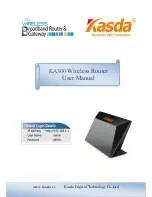
Adaptive AP
10-15
10.4.3 Adaptive AP Deployment Considerations
Before deploying your switch/AAP configuration, refer to the following usage caveats to optimize its
effectiveness:
•
Extended WLANs are mapped to the AP’s LAN2 interface and all independent WLANs are
mapped to the AP’s LAN1 Interface.
•
If deploying multiple independent WLANs mapped to different VLANs, ensure the AP’s LAN1
interface is connected to a trunk port on the L2/L3 switch and appropriate management and
native VLANs are configured.
•
The WLAN used for mesh backhaul must always be an independent WLAN.
•
The switch configures an AAP. If manually changing wireless settings on the AP, they are not
updated on the switch. It's a one way configuration, from the switch to the AP.
•
An AAP always requires a router between the AP and the switch.
•
An AAP can be used behind a NAT.
•
An AAP uses UDP port 24576 for control frames and UDP port 24577 for data frames.
•
Multiple VLANs per WLAN, L3 mobility, dynamic VLAN assignment, NAC, self healing,
rogue AP, MU locationing, hotspot on extended WLAN are some of the important wireless
features not supported in an AAP supported deployment.
Summary of Contents for P-7131N-FGR
Page 1: ...Motorola Solutions AP 7131N FGR Product Reference Guide M ...
Page 3: ...AP 7131N FGR Access Point Product Reference Guide ...
Page 4: ......
Page 14: ...Motorola Solutions AP 7131N FGR Access Point Product Reference Guide 10 ...
Page 46: ...Motorola Solutions AP 7131N FGR Access Point Product Reference Guide 1 30 ...
Page 57: ...Hardware Installation 2 11 ...
Page 70: ...Motorola Solutions AP 7131N FGR Access Point Product Reference Guide 2 24 ...
Page 90: ...Motorola Solutions AP 7131N FGR Access Point Product Reference Guide 3 20 ...
Page 224: ...Motorola Solutions AP 7131N FGR Access Point Product Reference Guide 5 78 ...
Page 296: ...Motorola Solutions AP 7131N FGR Access Point Product Reference Guide 6 72 ...
Page 692: ...Motorola Solutions AP 7131N FGR Access Point Product Reference Guide B 10 ...
Page 699: ......
















































